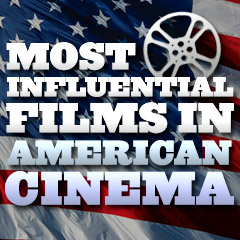Most Influential, Significant
and Important Films in American Cinema
(chronological by time period and film title)
|
|
Title Screen
|
Film Title/Year/Director/Length/Studio,
Descriptions of Influence/Significance |
Poster
|
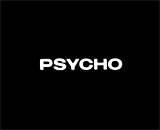
|
Psycho (1960)
d. Alfred Hitchcock, 109 minutes, Shamley Productions/Paramount
Pictures
- This remains the greatest, most influential Hitchcock
horror/thriller ever made and the progenitor of the modern Hollywood
horror-slasher film, based on Robert Bloch's novel. The complex
story included the untimely, violent murder of the main protagonist
early in the film (a monumental first that was later copied in Scream
(1996) with Drew Barrymore),
a cross-dressing transvestite murderer (portrayed brilliantly by
Anthony Perkins), insanity, a stuffed corpse, and Oedipal Freudian
motivations. Hitchcock's techniques voyeuristically
implicated the audience with the universal, dark evil forces and
secrets present in the film.
- The nightmarish, disturbing film's themes of corruptibility,
confused identities, voyeurism, human vulnerabilities and victimization,
the deadly effects of money, Oedipal murder, and dark past histories
were realistically revealed. Its themes were revealed through repeated
uses of motifs, such as birds, eyes, hands, and mirrors.
- Considered the "mother" of all modern
horror, scream-inducing suspense films. A risky horror film, it
invented the contemporary psychological thriller. It single-handedly
ushered in an era of inferior screen 'slashers' with blood-letting
and graphic, shocking killings by serial killers (e.g., Peeping
Tom (1960, UK), Homicidal
(1961), The Texas Chainsaw Massacre (1974), Halloween
(1978), Friday the
13th (1980), and Motel Hell (1980), and many more).
- As a supremely manipulative tale, it
included the most celebrated shower sequence ever made. The
shocking, brilliantly-edited, and notorious 3-minute shower murder
scene, accompanied by screeching violins (Bernard Herrmann's famous
and frightening score with shrieking, harpie-like piercing violins),
included about 90 different shots pieced together as a montage.
Many parodies or imitations of the slasher-shower scene have been
made - including most famously in Brian De Palma's Dressed to
Kill (1980).
- The low-budget
($806,000), brilliantly-edited, stark black and white film was
shot cheaply with a TV crew. Its revenue grosses (domestic and worldwide)
totaled about $32 million.
- Psycho broke all film conventions and redefined
cinema by displaying its leading female protagonist Marion Crane
(Janet Leigh) having a lunchtime affair in her sexy white undergarments
in the first scene (to cheat the Production Code); also by photographing
a toilet bowl - and flush - in a bathroom (a first in an American
film), and killing off its major 'star' a third of the way
into the film - something duplicated by many films since. It also
included such taboo topics as transvestism, implied incest, and
hints of necrophilia.
- There were many brilliant lines of dialogue, including:
"A boy’s best friend is his mother."
- When the film was originally aired in theaters,
Hitchcock insisted on a clever marketing ploy. The publicity gimmick
(a la P.T. Barnum) was that there would be "no late admittance"
to the theatre after the film had begun. Strictly enforced, the decree was
carried out by uniformed Pinkerton guards. Audiences assumed, wrongly,
that something horrible would happen in the first few minutes.
- Violence was present for about two minutes
total in only two
shocking, grisly murder scenes, the first about a third of the
way through (the shower killing), and the second when Phoenix detective
Arbogast (Martin Balsam) was stabbed at the top of a flight of stairs
and toppled backwards down the staircase. The remainder of the horror
and suspense was created in the mind of the audience.
- Following up were three sequels (of lesser quality)
that all featured Anthony Perkins: Psycho II (1983), Psycho
III (1986) (with Perkins as director),
and Psycho
IV: The Beginning (1990) (TV Movie), plus Gus Van Sant's
shot-by-shot remake Psycho (1998), the TV pilot movie Bates
Motel (1987), and A&E's prequel
series Bates Motel (2013-2017).
|
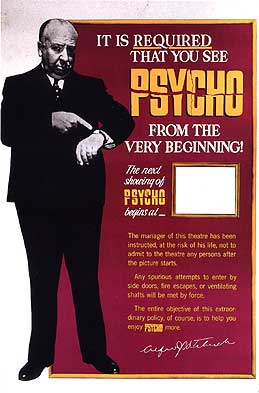
|
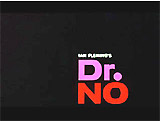
|
Dr. No (1962)
d. Terence Young, 110 minutes, United Artists/Eon Productions
- This was the first of the James
Bond series of action-packed spy thrillers, and it
played a key role in establishing the Bond character as a recognizable
icon in popular American contemporary culture. Bond began as
a well-known literary figure in the works of British writer
Ian Fleming (the first Bond book was Casino Royale,
written in 1953).
- Although this film was notable as the first in the
series, From
Russia With Love (1963) is
considered by many to be the definitive James Bond film, also directed
by Terence Young.
- The plot of this low-budget film was a timely one
- it capitalized on the problems America was having with missile
launches, and the changing mood of the country in the early 1960's. It
debuted the recurring villainous organization - SPECTRE (SPecial Executive
for Counter-intelligence, Terrorism, Revenge, Extortion). SPECTRE's
head villain dreamed of "world domination" by interfering
with, disrupting and sabotaging American space rockets (and their launches)
with an atomic-powered, "toppling" radio beam. He was targeting
the Project Mercury missile launch from Cape Canaveral. Bond was sent
to investigate radio interference in Jamaica during rocket launches,
and some mysterious deaths. The Bond villain was portrayed by SPECTRE
operative - reclusive and menacing half-Chinese Dr. Julius No (Joseph
Wiseman) (with metal prosthetic hands), noted for unusual murders (via
'three blind mice' assassins, a deadly tarantula, etc.)..
- Dr. No established many of the trademarks
of all future films in the series, including a clever opening
title credits sequence (the 'gun-barrel' view),
trademark theme music, sexy and beautiful women ('Bond
Girls' with ridiculous
names), great diabolical villains, exotic international locales,
the calm manner and witty, subtle humor and repartee of the mythic
hero 007, violence and weapons (Bond's Walther PPK), terrific action
sequences, stunts and chase scenes, narrow escapes, gimmicks, humor,
and great cinematography.
- Its predictable formula starred the debonair,
dashing and charming British "Secret
Agent 007," James Bond (with the definitive Bond played by Sean Connery, who introduced
himself as "Bond, James Bond"), with great taste in clothes, wine,
food, and exotic, sexy women. In this film, Honey Ryder (Ursula Andress) was the definitive voluptuous
Bond girl, rising from the water in a white bikini.
|
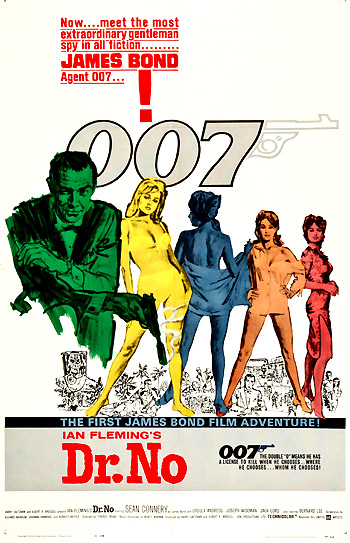
|
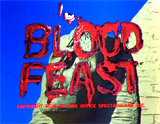
|
Blood Feast (1963)
d. Herschell Gordon Lewis, 67/58 minutes, Friedman-Lewis Productions/Box Office
Spectaculars
- Sexploitation gore-fest director Herschell Gordon
Lewis' career was launched with this low-budget cult film (starring
June 1963 Playboy
Playmate Connie
Mason), filmed in only 9 days (with a budget of $25,000). The crude
and salacious Z-grade horror film is usually considered to be the
first distinctive horror 'splatter' film for its excessive gore,
blood, violence, and bodily mutilation. [Note: Claims were made that
it was the first horror film in which a tongue was ripped out of
a person's mouth.]
- It went much further than its inspiration -
Hitchcock's
Psycho (1960), with graphic depictions
of the gory results of bizarre ritualistic murders - filmed in
rich bright color. It paved the way for the existence of many blood-drenched,
'meat grinder-horror' films to follow, including George Romero's Night
of the Living Dead (1968), Wes Craven's The Last House
on the Left (1972), The Texas Chain Saw Massacre (1974),
the Friday the 13th films,
and even Sam Peckinpah's The
Wild Bunch (1969).
- It was the first film in Lewis' "Blood
Trilogy" -
followed by 2000 Maniacs! (1964) and Color Me Blood Red
(1965). Lewis, dubbed "the godfather
of gore," made a career out of similarly gory, low-budget
drive-in films for the next decade (i.e., A Taste of Blood (1967),
The Gruesome Twosome (1967), Something Weird (1967), The Wizard of
Gore (1970) and The Gore Gore Girls (1972)).
|

|
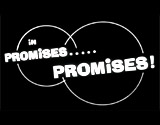
|
Promises! Promises! (1963)
d. King Donovan, 75 minutes, Noonan-Taylor Production/NTD
- Buxom, platinum
blonde sex goddess/siren Jayne Mansfield (former Playboy Playmate
in February 1955, similar to rival Marilyn Monroe) appeared naked
(breasts and buttocks only) in this unrated sex farce. Thus, she became
the first mainstream
actress to appear nude in an American feature sound film. [Note:
the honor would have been held by Marilyn Monroe in Something's
Gotta Give (1962), but she died during production.]
- It was another landmark indication in the decade
of the 60s that the Production Code's impositions were deteriorating
and being liberalized, and more broken barriers (and nudity)
would follow. [Note: Sidney Lumet's serious film The Pawnbroker
(1965) was the first US film to show a woman nude from the
waist up that was granted a Production Code seal - ultimately breaking
the back of the Production Code's restrictions.]
- Mansfield sang "I'm In Love" in
a foamy, bubbly bathtub, and then toweled off and toplessly writhed
around on a bed. The original version was banned in many cities
(including Cleveland) and substituted with an edited version. In
order to have the film available, it was distributed independent
of the major studios.
- The provocative film was heavily publicized (pre-release)
in Playboy's
June 1963 issue in
a pictorial titled The Nudest Jayne Mansfield, with more revealing
pictures to prove it, that led to the magazine's Chicago publisher
Hugh Hefner being charged with obscenity (and later acquitted)
-- the only time in his life.
- Later, the sex film became available for purchase
on Super 8MM in the 1970s, was debuted uncut on cable-TV's
Playboy Channel in 1984.
|

|

|
Dr. Strangelove Or: How I Learned
to Stop Worrying and Love the Bomb (1964, US/UK)
d. Stanley Kubrick, 95 minutes, Columbia Pictures/Hawk Films
- Producer/director Stanley
Kubrick's brilliant, satirical, provocative black comedy/fantasy
regarding doomsday and Cold War politics featured an accidental,
inadvertent, pre-emptive nuclear attack. The undated, landmark
film - the first commercially-successful political satire about
nuclear war, has been inevitably compared to another similar suspense
film released at the same time - the much-more-serious and melodramatic
Fail-Safe (1964).
However, this was a cynically objective, Monty Python-esque, humorous,
biting response to the apocalyptic fears of the 1950s.
- The black comedy, a cautionary tale, was about a
possible nuclear Armageddon at the hands of inept politicians,
arrogant scientists, and military figures with lunatic concerns
about fail-safe points, hotlines, and Communist plots such as flouridation.
- The mid-1960s film's nightmarish, apocalyptic theme
was about how technology had gone haywire and had dominated humanity.
The film's anti-war fears actually became a plausible scenario,
shortly after the assassination of President Kennedy, the Bay of
Pigs fiasco and the heated-up intensification of the Cold War and
nuclear arms race.
- In response to the film's scary nuclear scenario
in the mid-1960s and later, security measures and changes were
made to actual military and procedural policies as further safeguards
to prevent the authorization of implementing a nuclear weapon without
the President’s
approval. One of the new policies, instituted in the early 1970s,
was to add coded switches to the control systems of American missiles
and bombers to guard against an unauthorized nuclear strike. A
two-man rule was also required to make it more difficult for
someone to use a nuclear weapon without permission.
- The funny (and frightening), dark film cleverly
cut back and forth mid-scene (and increased in rapidity as the
film drew to an insane close) from three main set locations, each
with their own distinctive camera styles: a sealed-off Air Force command
base led by a psychotic, impotent bomb-group commander, the cramped,
flight deck interior of a B-52 bomber, and the Pentagon's huge underground
War Room with an inept US
President, a saber-rattling general
(and other military brass), a Soviet ambassador, and a crazed German
nuclear scientist (Dr. Strangelove).
- It received four Academy Award nominations
(with no wins): Best Picture, Best Actor (Peter Sellers),
Best Director, and Best Adapted Screenplay - losing the first
three Oscars to the popular My Fair Lady
(1964),
and the Screenplay award to Becket (1964). Dr. Strangelove was
most memorable for Peter Sellers' Oscar-nominated, masterful performances
in three distinct roles in two of the three set locales.
- Memorable scenes included the classic polite phone
call to the drunken Soviet Premier Dmitri Kissof by American President
Merkin Muffley (Peter Sellers), the line of dialogue: " "Gentlemen.
You can't fight in here. This is the War Room!", and
the entertaining characterization of wheelchair-bound, falsetto-
and German-accented Dr. Strangelove (also Sellers), who owned an
independently-minded mechanical right hand, and exclaimed his final
line: "Mein
Fuhrer! I can walk!" Strangelove
became ecstatic over the total annihilation of the Earth and his
100 Year Plan (including his mine-shaft proposal that suggested
having 10 fertile women for every male survivor), as the Doomsday
Machine was triggered.
- The
film concluded with
the memorable bucking broncho image of Major Kong (Slim Pickens)
riding the fatal bomb from the B-52 bomber and howling wildly toward
oblivion: "YAHOO!!
YAHOO!!" A climactic chorus of H-bomb mushroom clouds spread
as multiple explosions detonated around the world, annihilating and
causing oblivion by bringing radioactive fallout to millions of people.
The popular, comforting WW II tune We'll Meet Again Some Sunny
Day played in incongruous juxtaposition.
|
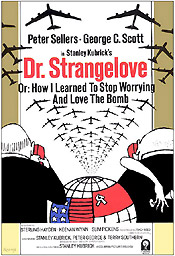
|
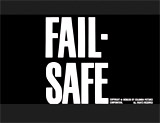

|
Fail-Safe (1964)
d. Sidney Lumet, 112 minutes, Columbia Pictures
- This realistic Cold War political drama about
a potential, disastrous apocalyptic nuclear war was adapted from
the 1962 best-selling novel by Eugene Burdick and Harvey Wheeler
- around the time of the Cuban Missile Crisis. In its dramatization
of the controversial themes of the arms-race and possibilities
of nuclear holocaus, it helped to demystify the workings of the
top-secret US national security system at the time. It also helped
to humanize Soviets as real people (rather than faceless monsters)
to American audiences.
- One of the earliest
films in this sub-genre about nuclear warfare was Norman
Taurog's and MGM's fictionalized The Beginning or the End
(1947), a docu-drama about
the development of the first atomic bomb dropped on Hiroshima,
Japan. During the decade of the 1950s, there were a number of
low-budget sci-fi films about giant creatures awakened or mutated
by a nuclear bomb, such as The Beast from 20,000 Fathoms (1953),
Godzilla (1954, Jp.),
Them! (1954), and Beginning of the End (1957),
and metaphoric films about alien Communist invasion (i.e., Invasion
of the Body Snatchers (1956)). Two of the best, more serious
works were Arch Oboler's sci-fi horror film
Five (1951) - about five survivors left on Earth after an
atomic bomb blast, and Stanley Kramer's On
the Beach (1959) - about Australians in the aftermath of nuclear
war who faced certain doom from radioactive fallout.
- Fail-Safe was an effective
and taut political doomsday disaster film during the Cold War
era about reaching "the brink of eternity." It was
a serious, illuminating and very bleak version of Stanley Kubrick's
black comedy Dr.
Strangelove, Or: (1964)), although much less successful.
The dramatic and commercial impact of Fail-Safe was severely
lessened by the earlier release of Kubrick's satire. The latter
film's depressing message was about how World War III could
actually happen.
- In this "what-if" hypothetical melodrama
and suspenseful cautionary tale, malfunctioning faulty computer
transmissions from Strategic Air Command (SAC) headquarters in
Omaha erroneously misguided an Alaska-based squadron of US bombers
with atomic weapons flying towards Moscow to attack. Although
most of the bombers were successfully called back, one squadron
of bombers had passed the 'fail-safe' position (beyond which
pilots would no longer have to follow orders) in Soviet air space,
due to Soviet radio jamming, and was headed towards Moscow. In
the tense drama (a 'race against time' scenario), one fanatical,
power-hungry, hawkish civilian nuclear scientist (Walter Matthau)
recommended declaring war on the Soviets, while Brigadier General
Black (Dan O'Herlihy) wished to avoid an all-out nuclear holocaust.
In an underground fall-out shelter, the President (portrayed
by Henry Fonda) ordered the planes shot down, and informed the
Russian Premier leader (via telephone hotline) of the mistaken
orders. One of the planes, piloted by group commander Colonel
Grady (Edward Binns), managed to continue its mission and wouldn't
turn back, and released its bombs over Moscow. To appease the
Russians and the world, the President ordered US planes to release
an atomic bomb over NYC to annihilate the metropolis in the downbeat
conclusion.
- Experienced in TV and theatre production, Lumet's
stark and shadowy black and white film was made more effective
by claustrophobic sets, close-ups, ensemble casting, and the
use of in-camera techniques, including zoom shots within scenes,
freeze frames and negative images. These kinds of effects were
mostly used only in independent films and foreign films.
The film was also devoid of background music, enhancing stretches
of tense and ponderous silence with a feeling of doom.
|

|
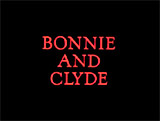
|
Bonnie and
Clyde (1967)
d. Arthur Penn, 111 minutes, Warner Bros./Seven Arts
- One of the sixties' most talked-about, volatile,
controversial crime/gangster films combined comedy, terror, love,
and ferocious violence. This innovative, revisionist
film redefined and romanticized the genre and the depiction
of screen violence forever.
- Director Arthur Penn's violent biodrama was promoted
with this slogan for its violent anti-heroes: "They're young.
They're in love. They kill people." It was a romanticized,
fictionalized account of two 1930s bank robbers, portrayed as counter-cultural,
romantic fugitives and likable folk heroes with semi-mythic celebrity
status.
- The anti-establishment, violent film, originally
criticized at the time of its release, was aimed at youth audiences
by its American auteur and producer/star Warren Beatty. The film's
sympathetic, revolutionary characters and its social criticism
appealed to anti-authority American youth at the time who were
part of the counter-cultural movement protesting the Vietnam War,
the corrupt social order, and the U.S. government's role.
- The film, with many opposing moods and shifts in
tone (from serious to comical), was a cross between a gangster
film, tragic-romantic traditions, a road film and buddy film, and
screwball comedy. Cartoon-style slapstick comedy [a tribute to
Mack Sennett's silent films and Keystone Kops car chases and getaways]
and banjo music (e.g. Foggy Mountain Breakdown from Lester
Flatt and Earl Scruggs, helped to introduce country music to mainstream
films) and ballads accompanied many of the film's scenes.
- The anti-establishment film was ultimately a popular
and commercial success (but it started out with only mediocre box-office
results). It was first widely denounced and criticized at the
time of its release by film reviewers for glamorizing the two killers. In
the autumn of 1967, it opened and closed quite quickly - enough
time for it to be indignantly criticized for its shocking violence,
graphic bullet-ridden finale and for its blending of humorous farce
with brutal killings. Then, after a period of reassessment, there
were glowing reviews, critical acclaim, a Newsweek cover
story, and the film's re-release - and it was nominated for ten
Academy Awards.
- Newcomer Faye Dunaway became a major screen actress
as a result of her breakthrough in this influential film.
- The influence of the film extended to commercial
merchandise in the form of hairstyles, authentic period music of
the 30s, and gangster retro-clothing (such as double-breasted suits,
berets, fedoras, and the maxi-skirt). The film also permanently
changed the form and substance of popular films.
- It exemplified many of the characteristics of experimental
film-making from the French New Wave (Nouvelle Vague) movement,
inspiring a new generation of film-makers in a new Golden Age. Penn
followed up with the genre-breaking western Little Big Man (1970).
|
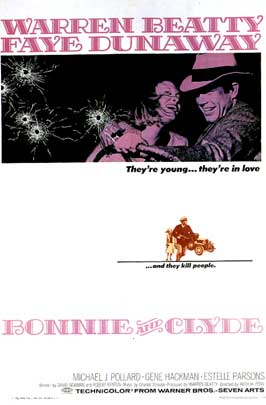
|
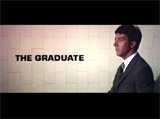
|
The Graduate (1967)
d. Mike Nichols, 106 minutes, Lawrence Turman/Embassy Pictures
- The influential, defining and groundbreaking film
of the late 1960s was a biting satire/comedy about the shifting,
social and sexual mores of the 1960s. It helped to set in motion
a new era of film-making, for a new generation of film-makers including
Arthur Penn, Stanley Kubrick, Martin Scorsese, Oliver Stone, Francis
Ford Coppola, Woody Allen, and Robert Altman.
- The influential film was a biting satire/comedy
about coming of age. Its main character was a recent nebbish, East
Coast college graduate who found himself alienated, exploited,
seduced, betrayed, restless and adrift in the shifting, social
and sexual mores of the 1960s, and questioning the values of suburban,
upper-middle-class society (with its keyword of advice -- "plastics").
Its portrayal of a corrupt, banal, decadent, and discredited older
generation was well understood by film audiences and captured the
spirit of the times. It echoed the dissatisfaction with the 'phony'
adult world found in J.D. Salinger's popular novel Catcher in
the Rye.
- The themes of the mature film mirrored the changes
occurring in Hollywood, as a new vanguard of younger directors
was coming to the forefront. There was already a growing dissatisfaction
with the status quo and middle-class values, and the breakthrough
film mirrored that anarchic mood perfectly for America's youth
of the 60s during the escalation of the Vietnam War.
- Avant-garde director Mike Nichols was following
his debut success with the scandalous Who's
Afraid of Virginia Woolf? (1966) with this second film.
He instantly became a major new talent in American film after winning
an Academy Award (the film's sole Oscar) for his directorship.
Mike Nichols became the first director to earn $1,000,000 salary
for a single picture - for this watershed film. His next two films
continued to explore controversial issues: Catch-22 (1970) and
Carnal Knowledge (1971).
- It was inspired and complemented by the visually-synchronized
music of the popular singing duo Simon and Garfunkel from their
Grammy-winning The
Sounds of Silence album (with songs composed earlier and previously-released
except for "Mrs. Robinson"), with meaningful, haunting
lyrics amidst koo-koo-kachoo sounds to enhance the film's moods
and themes.
- 29 year-old stage actor Dustin Hoffman starred in
his first major film role as the 21 year-old title character,
struggling within a hopeless and confused love triangle (with a
middle-aged friend of the family and her daughter). Hoffman's career
began on stage, and then he appeared in a number of TV series,
but real recognition came with his striking role as the awkward
Benjamin Braddock.
|
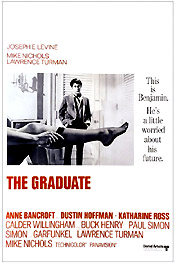
|

|
Guess Who's Coming to Dinner (1967)
d. Stanley Kramer, 108 minutes, Columbia
Pictures
- Stanley Kramer's family drama centered on
the controversial subject of inter-racial marriage and co-existence
- a central and prominent issue in the late 60s (a time of civil
rights riots), due to the fact that many states still forbid inter-racial
marrage until the Supreme Court struck down the 'anti-miscegenation'
laws. It was Hollywood's first mainstream
film about inter-racial marriage! Liberal director Stanley
Kramer was well-known for socially-relevant problem films, including
The Defiant Ones (1958) and Inherit
the Wind (1960).
- The old fashioned, semi-contrived Hollywood film
told about the controversial subject of inter-racial romance between
a black medical physician Dr. John Prentice (Sidney Poitier), a
widower, and his free-thinking fiancee Joanna ("Joey")
Drayton (Katharine Houghton, the actual niece of Oscar-winning
Katharine Hepburn) who had known him for only 10 days after meeting
during a Hawaii vacation. She was the sole young 21 year-old daughter
of liberal, affluent, upper-class mother and art-gallery owner
Christina Drayton (Katharine Hepburn) and
crusading newspaper publisher Matt Drayton (Spencer
Tracy in his final screen appearance), who lived in the San Francisco
Bay Area. The film opened with the couple's arrival at her upper-class
parents' home to announce their marriage and residence in
Switzerland, accompanying his work at the World Health Organization
in Geneva..
- Handsome, ground-breaking actor Sidney Poitier (a
typecast role for one of the biggest box-office stars at
the time), played the role of the highly-intelligent, successful,
respected and charismatic surgeon, whose conventional views,
perfection and mannerisms helped break down society's ethnic prejudices
and racial stereotypes.
- The film concluded with a powerful dramatic scene
of Matt's blessing of the future marriage,
by citing the one most important criteria for marriage - two people
who fall in love with each other - similar to his love for his
own wife Christina.
- The film acquired 10 Academy Awards nominations
(including Best Picture), and won two Oscars: Best Supporting Actress
(Hepburn), and Best Original Story/Screenplay.
|
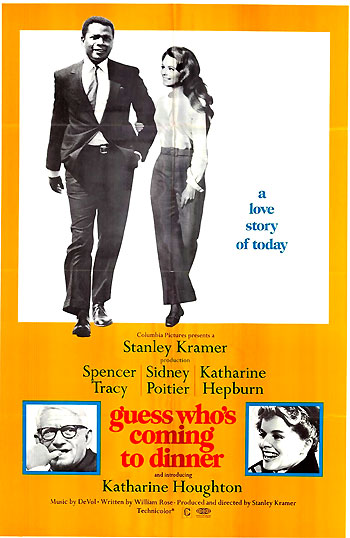
|
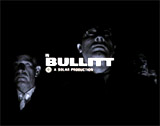
|
Bullitt (1968)
d. Peter Yates, 114 minutes, Warner Bros./Seven Arts
- This classic car-chase/cop film contained one of
the screen's all-time best car chase sequences (at up to 110 miles
per hour), for the 10-minute sequence filmed with hand-held cameras
up and down the narrow, hilly streets of San Francisco - and filmed
with actual cars (no rear projection). It redefined what a filmed
car chase should be, and star Steve McQueen performed most of his
own stunts..
- The crime film, mostly a police procedural, was
the future prototype for modern cop thrillers, especially for those
with rogue or maverick cop protagonists. It was influential for
the action thriller with Clint Eastwood, Dirty
Harry (1971).
- It set the standard for all
future car chase pictures with on-location filming, including The
Italian Job (1969), The
French Connection (1971), The Seven-Ups (1973), the Bourne films,
etc.
|
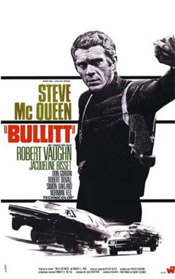
|
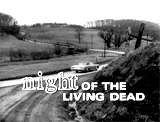
|
Night of the Living Dead (1968)
d. George Romero, 96 minutes, Image Ten/Laurel Group/Market
Square/Off Color
- The flesh-eating zombie sub-genre of films was given
a boost with George A. Romero's cheap, stark black and white horror
flick - a B picture cult classic and one of the most successful
independent films ever made. His debut film was an influential,
milestone 'splatter' film. Its controversial and unconventional
themes included cannibalism, matricide, and a heroic black protagonist
(a rarity in the 1960s).
- The ultra-low budget film was shot in grainy 35
mm with natural lighting and hand-held cameras to accentuate the
fear facing the besieged farmhouse occupants. It featured an unknown
cast (uncredited in the film's opening) - and reinvented the genre
with its crude "drawbacks" which
actually improved the film since they lent a documentary feel and
reality that made the film all the more horrific.
- Although the film was not the first zombie film,
it established a prototype model for all future zombie films. It
marked the debut of the 'modern' zombie film that portrayed zombies
as resurrected, cannibalistic 'flesh-eaters' or 'ghouls.' (Previously,
zombies were portrayed as mutants, or as trance-like undead slaves
magically produced by voodoo rites and thereafter obedient to their
sorcerer-masters.) It
quickly became director Romero's calling card, and was responsible
for making him influentially known as the Master of the modern 'zombie film'
(although the term 'zombie' was never explicitly used), featuring
the mysterious reanimation (or reactivation) of the recent-dead.
- It
ushered in the modern era of graphically violent and gory zombie
pics in the waning years of the 60s decade when there was such
social upheaval. Romero's first Dead film
appeared at the same time as civil unrest, Black Power and student
protests, the Vietnam War, fear of nuclear annihilation, the gruesome
assassinations of Robert Kennedy and Martin Luther King, Jr., and
the breakdown of the family - all coupled with the idealistic innocence
of the previous year's Summer of Love. US society and politics
appeared to be overrun by unexplainable
and irrational forces - similar to the zombies who attacked en
masse for no apparent reason.
- While initially
considered schlock (in the waning years of drive-ins), the
notorious film of brutal and relentless claustrophobic horror
gained in popularity and critical respect, and raised Romero to
great heights as a horror filmmaker.
- Romero's Dead trilogy told about flesh-eating
zombies who walked slowly and stiffly (due to the effects of rigor
mortis), in a 'cult of the dead'. It was the precursor of
many other zombie films (Romero's and others) in which the bloodthirsty
'undead' arose, e.g., the Resident Evil films, the UK's 28
Days Later (2002),
and the zombie spoof Shaun of the Dead (2004), as well as
AMC's The Walking Dead series. It defined the modern horror
movie and influenced a number of US and international horror directors,
including Dario Argento, David Cronenberg, and Tobe Hooper.
|
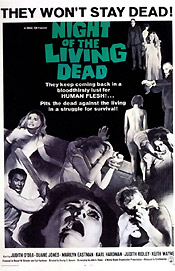
|
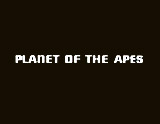
|
Planet of the Apes (1968)
d. Franklin J. Schaffner, 112 minutes, 20th Century Fox/APJAC Productions
- This was the first in a popular, clever, mostly
successful and serious five-film series of classic simian films
about apes that had evolved into an intelligent society, derived
from Pierre Boule's 1963 novel Monkey Planet. Pre-Star
Wars (1977),
it was one of the most successful sci-fi franchises of all time.
- The first film in the series - Planet
of the Apes (1968) - depicted
a post-apocalyptic, post-nuclear futuristic planet (Earth) - revealed
in the film's startling conclusion by a half-submerged Statue of
Liberty.
- There were four sequels to this film from 1970 to
1973: Beneath
the Planet of the Apes (1970), Escape
From the Planet of the Apes (1971), Conquest
of the Planet of the Apes (1972), and Battle
for the Planet of the Apes (1973). There were also
two TV series, one live-action and one animated: CBS-TV's Planet
of the Apes (1974), and the animated Return to the Planet
of the Apes (1975). Finally, there was a reboot or reimaging
of the film, Tim Burton's Planet of the Apes (2001), followed
by another 'reboot' trilogy: Rise
of the Planet of the Apes (2011), Dawn
of the Planet of the Apes (2014), and War for the Planet
of the Apes (2017).
- Its advanced make-up techniques reversed the social
positions of intelligent humans and brutal apes to slyly criticize
and satirize racial and class stereotypes. It also examined the
effects of technology upon humankind. It
provided both solid entertainment value, and an effective, politically-charged
message of social commentary.
- This classic science fiction film was one of the
pioneering, modern multimedia marketing blockbusters. Besides a
long-running series, it also promoted a large-scale merchandising
spin-off of 'Ape'-related products. There were
tie-ins to action figures, toys, collectibles, story/picture books,
Topps bubble-gum trading cards, hardcover and paperback books (of
the source novel), a record soundtrack, and comic book adaptations.
|
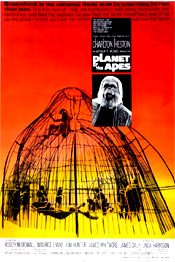
|
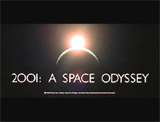
|
2001: A Space Odyssey (1968, US/UK)
d. Stanley Kubrick, 160/146 minutes, MGM/Stanley Kubrick
Productions
- Kubrick's
respectable, influential film (with less than 40 minutes
of dialogue), filmed in Super Panavision, was based on Arthur C.
Clarke's novel. It quickly became the most celebrated, mystical
and transcendent of all space films up to that time.
- Kubrick's last film in the 60s was the most successful science
fiction film of the decade with a story that spanned all of human
history with giant leaps (from pre-historic cave-dwelling apes jump-cutting
ultimately to futuristic outer space travelers to Jupiter). A continuing
theme was the reception of an extra-terrestrial signal in its portrayal
of man (bored in his technological paradise) confronting technology
beyond his control.
- The impressive film featured an incredible opening
enhanced by Richard Strauss' Also Sprach Zarathustra, a
'Dawn of Man' sequence, majestic views of outer space and drifting
space stations, enigmatic monoliths, the breakdown of a malevolent
HAL super-computer, an astronaut's journey to Jupiter (paralleling
man's own growth of intelligence), a hallucinatory light show trip
through space (enthralling to many pot-smokers), and a cryptic
ending featuring a super-being space fetus.
- It boasted spectacular
visuals, landmark special effects, classical music, a psychedelic
light-show ride (that appealed to late 60s 'tripping' viewers)
and the memorable, flawed HAL supercomputer (with the uncredited
voice of Douglas Rain). The memorable
anthropomorphic character of HAL, a computer that could see, speak,
hear, and think like its human colleagues, was omnipresent aboard
the spaceship.
- Stanley Kubrick's stunning epic reinvented the science
fiction genre - after its premiere in April 1968. It earned four
Academy Award nominations and won the Oscar for Best Visual Effects,
for its pioneering F/X by Douglas Trumbull.
- It restored unsurpassed
legitimacy to the science-fiction genre. Now, sci-fi could be
serious, and visionary - without
cheap B movie monsters, such as in the previous era's films. It
provided a predictive and prophetic look at the future of space
travel, with incredible magnificence and seriousness.
- Kubrick's film was a kickstarter for a Golden Age
of space-related science-fiction films, such as: Silent Running
(1972), Solaris (1972, USSR), Star Wars (1977) and Close Encounters
of the Third Kind (1977).
|

|
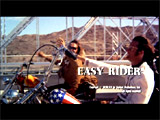
|
Easy Rider (1969)
d. Dennis Hopper, 95 minutes, Columbia Pictures
- Easy Rider, surprisingly, was an extremely
successful, low-budget (under $400,000), counter-cultural, independent
film for the alternative youth/cult market - one of the first of
its kind that was an enormous financial success, grossing $40 million
worldwide.
- A new wave of independent film-making in Hollywood
(dubbed "The New Hollywood") was signaled by Dennis Hopper's
anti-Establishment release of his low-budget "road film."
Its phenomenal success shook up the major Hollywood studios, and
spawned many imitators - as well as made supporting actor Jack
Nicholson a star.
- This movement was termed Hollywood's New Wave
(fashioned after the earlier French New Wave), and would last through
the next decade. The pop cultural, mini-revolutionary
film was also a reflection of the "New Hollywood," and
the first blockbuster hit from a new wave of Hollywood directors
(e.g., Francis Ford Coppola, Mike Nichols, Peter Bogdanovich, Martin
Scorsese, and others) that would break with a number of Hollywood
conventions.
- It was a ritualistic
experience and viewed (often repeatedly) by a new generation of
youthful audiences in the late 1960s as a reflection of their realistic
hopes of liberation and fears of the Establishment. The
tone of this 'alternative' film was remarkably downbeat and bleak,
reflecting the collapse of the idealistic 60s.
- The late 1960s tale, a seminal "road film,"
was about the search for freedom (or the illusion of freedom)
in a conformist and corrupt America in the midst of paranoia,
bigotry and violence.
It can be
both memorialized as an image of the popular and historical culture
of the time and a story of a contemporary but apocalyptic journey
by two self-righteous, drug-fueled, countercultural, anti-hero
(or outlaw) bikers, both dropouts, as they went eastward through
the American Southwest.
- Its story contained sex, drugs, casual violence,
a sacrificial tale (with a shocking, unhappy ending), and a pulsating
rock and roll soundtrack reinforcing or commenting on and complementing
the film's themes.
- The influential film led to a flurry of equally
self-indulgent, anti-Establishment themed films by inferior filmmakers,
who overused some of the film's technical tricks and exploited
the growing teen-aged market for easy profits.
|
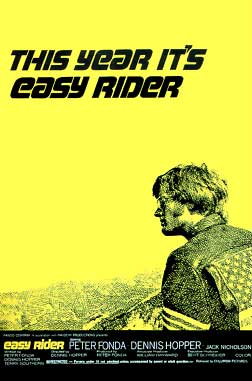
|
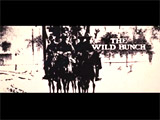
|
The Wild Bunch (1969)
d. Sam Peckinpah, 145 minutes, Warner Bros./Seven Arts
- Director/co-writer Sam Peckinpah's provocative,
brilliant yet controversial Western, shocking for its graphic and
elevated portrayal of violence and savagely-explicit carnage, yet
hailed for its truly realistic and reinterpreted vision of the
dying West in the early 20th century.
- The ultra-violent western was
exceptional for its non-glorification of bloodshed, and its slow-motion,
heavily-edited, stylized views of multiple deaths. It
increased the acceptance and tolerance level for violence on the
screen - a lasting influence that has been seen in the imitative
graphic violence of the films of Martin Scorsese, Quentin Tarantino,
John Woo, and others.
- The slaughter
of innocent bystanders, and the use of women as shields (in the
all-male film) were served up as counterpoints to the media's honest
display of violence during the late 60s, with the Vietnam War,
assassinations, urban riots, and other events filling the airwaves.
Due to its violence, the film was originally threatened with an
X-rating by the newly-created MPAA (Motion Picture Association
of America), but an R-rating was its final decision.
- Many of the film's major stars, including William
Holden, Edmond O'Brien, Robert Ryan and Ben Johnson, were veterans
of westerns with a more romantic view of the West in the 40s and
50s. The anti-heroic 'wild bunch' represented contemporary American
soldiers in the late 60s, out of place in the jungles of Vietnam.
- With numerous, elaborate montage sequences with
staccato shifts, the film set a record for more edits (3,643 shot-to-shot
edits at one count) than any other Technicolor film up to its time.
|
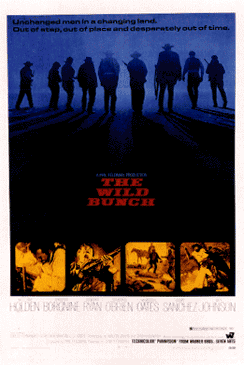
|
